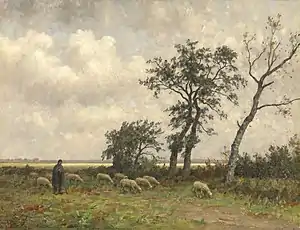Alphonse Stengelin
Alphonse Stengelin (1852-1938) was a French painter, engraver, and lithographer who spent much of his life working outside France. He is remembered mostly for his landscapes.
Alphonse Stengelin | |
|---|---|
 | |
| Born | 26 September 1852 |
| Died | 12 March 1938 (aged 85) |
Biography
He was born in a home that had been designed by the architect Jacques-Germain Soufflot, designer of the Panthéon. His parents were Swiss.[1][2][3][4] His father was a banker, associated with the banking house of Evesque & Cie.[5]

After studying at the Collège-lycée Ampère, he enrolled at the École des beaux-arts de Lyon and became a student of the school's Director, Joseph Guichard. He also worked with Augustin Chenu and Florian-Némorin Cabane (1831-1922), both landscape painters.[6] He spent much of his time copying the Old Masters at the Musée des beaux-arts de Lyon and was a great admirer of Rembrandt.[5]
He eventually went to Paris and opened a small studio in Montmartre. From 1875 to 1910 he travelled extensively, visiting Germany, Switzerland and Italy.[5] As the years passed, he spent more time in the Netherlands, where he not only painted but also produced engravings of his earlier paintings.[7] The small towns of Hooghalen and Katwijk and the farming country of Bresse were among his favorite locations.[5]
In 1888, he married his cousin, Coraly Stengelin (1860-1945) and they had four children. A street in Katwijk was named after him in 1907, after which he signed his works as "Stengelin van Katwijk".[5] Until 1914, he divided his time between the Netherlands and a small house in Écully. In 1978, a "Place Alphonse Stengelin" was dedicated there.[8]
He died in 1938 in Switzerland, where he had gone to live with his brother, Henri.
His works may be seen at the Musée des beaux-arts de Lyon, Musée des beaux-arts de Bordeaux, Musée des beaux-arts de Marseille and the Musée d'arts de Nantes.
References

- Reed, J. Eugene (1885). The Gallery of Contemporary Art: An Illustrated Review of the Recent Art Productions of All Nations. Gebbie & Company.
- Bénédite, Léonce (1924). The Luxembourg Museum: (Jeu de Paume Museum Annex, Tuileries Garden) : Its Paintings, Pastels, Aquarelles and Drawings : Foreign Schools. H. Laurens. p.45
- Reed, J. Eugene (1888). One Hundred Crowned Masterpieces of Modern Painting: Being a Collection of Photogravures, from the Most Celebrated Works of Contemporary Artists of All Nations. Gebbie & Company.
- Museum, Hague (Netherlands) Mesdag; Mesdag, Museum (1906). Catalogue of the Pictures, Drawings, Etchings and Objects of Art. Mouton and Company. p.61
- Les Guichets du savoir, notice biographique réalisée à partir des recherches du pasteur Ernest Christen (1932) et Nicole Lemoine (1985) — cf. bibliographie.
- Dictionnaire Bénézit
- Janine Bailly-Herzberg, Dictionnaire de l'estampe en France 183à-1950, Arts et métiers graphiques/Flammarion, 1985, pg.309.
- « Plus de convivialité pour la place Stengelin réhabilitée » (2010), sur le site officiel de la ville d'Écully, notice biographique d'après Nicole Lemoine (1985).
Further reading
- Philippe Zilcken, Catalogue descriptif des eaux-fortes et lithographies d'Alphonse Stengelin, La Haye, Mouton, 1910.
- Raymond Bouyer, "Alphonse Stengelin, peintre-graveur", In: Revue de l'art ancien et moderne, Paris, August 1910.
- Ernest Christen, Roger Oberkampf de Dabrun, Alphonse Stengelin van Katwijk. Sa Vie, son œuvre, publié a l’occasion de son 80e anniversaire, Genève/Écully, September 1932.
- Nicole Lemoine, Alphonse Stengelin, peintre lyonnais de la Hollande, mémoire de maîtrise, Écully, 1985 — Catalogue général de la BNF.
External links
| Wikimedia Commons has media related to Alphonse Stengelin. |